Adromischus humilis
Adromischus humilis (Marloth) Poelln.
Family: Crassulaceae
Common names: dwarf cliff adromischus (Eng.); bontkransrosie, bontkransnenta (Afr.)
Introduction
Adromischus humilis is a rare, cliff-hugging succulent from the southwestern Escarpment margin, between Sutherland and Beaufort West, in the Western Cape. The plants are dwarf, rosette-forming, leaf and stem succulents, the leaves green to purplish mottled. It flowers in summer the long inflorescence with yellowish-green tubular flowers, the lobes reddish-purple. Best grown in containers.
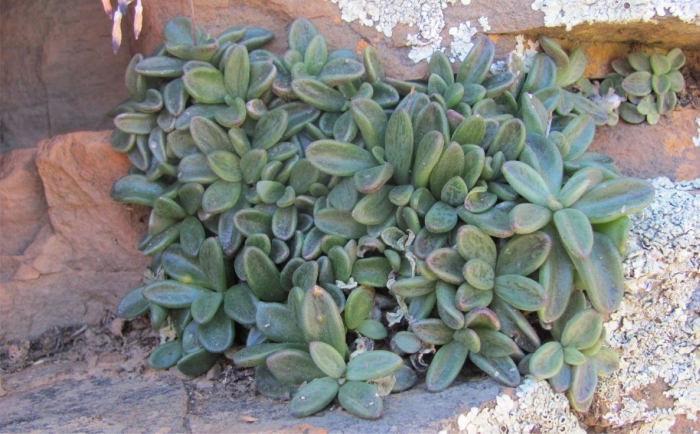
Fig. 1. A close-up of a cluster of Adromischus humilis growing on a sandstone ledge between Sutherland and Beaufort West, Western Cape, during the month of November.
Description
Description
Plants dwarf-sized, rosulate, prolific from base, forming dense, cliff-hugging clusters up to 200 mm in diameter and consisting of many heads. Rosettes 20–40 mm in diameter. The stems with a ring of grey, fusiform root tubers. Branches flaccid, the stolons proliferating forming dense mats. Leaves up to 8, ascending spreading to almost horizontal, firm but softly succulent, obovate to orbicular, sometimes elliptic, 10–15 × 5–8 mm, the base cuneate, the tip rounded, upper side concave or channelled, lower side rounded, surface smooth, green and often shiny, purplish mottled, the lower surface often purplish, margin entire. Inflorescence a thyrse, with 1–4 clusters (monochasia), each with 1–3 tubular flowers in the upper third. The flower (corolla) a narrow, tubular, yellowish-green funnel, 10–12 mm long, ending in 5 reddish-purple, broadly triangular-ovate, spreading lobes 2.5–3.5 mm long. Seeds small, wind dispersed. Flowering is mainly in summer (February, southern hemisphere).
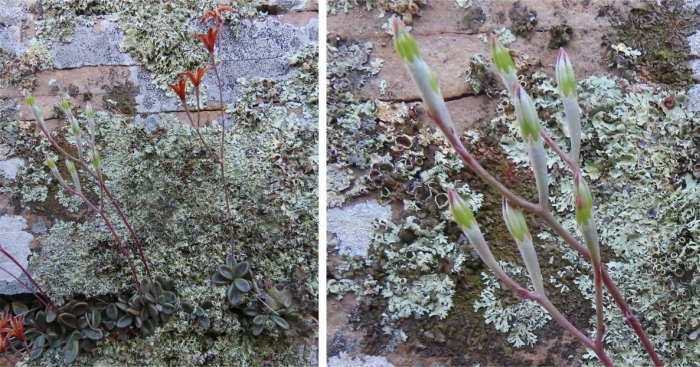
Fig. 2. A cluster of plants of Adromischus humilis almost in flower in early February, shaded by rocks, growing southwest of Beaufort West, Western Cape. Note the reddish-purple colour of the leaf and how the plants have filled the crevice allowed by the rock.
Conservation Status
Status
Classified as Least Concern (LC) by the Red List of South African Plants, Adromischus humilis is not threatened, the plants are safeguarded by their difficult to reach, cliff habitat and its distribution falls within a greater conservation area.
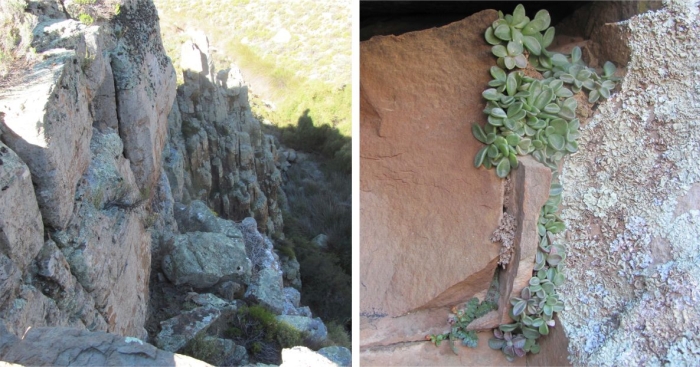
Fig. 3. Cliffs at Rooikloof, south west of the Karoo National Park, Western Cape, habitat of Adromischus humilis, and plants filling a vertical crevice. Note the numerous lichens, which are an indication of fog and dew, on which many cliff plants are dependent for moisture.
Distribution and habitat
Distribution description
Confined to the southwestern Escarpment Mountains between Beaufort West and Sutherland in the Great Karoo, Western Cape, where they grow on the sheer cliff-face. Plants were observed on mud-rock, sandstone and shale of the Adelaide subgroup, Beaufort Group of the Karoo Supergroup (Johnson et al. 2006). The depicted plants were photographed in Rooikloof between Sutherland and Beaufort West, on sheer cliffs near the Escarpment top.
The cliffs have many ledges, crevices and fissures, ideal for the establishment of plants. Adromischus humilis plants grow mainly on the cooler, shady, southern aspects at an altitude of 1 200–1 900 m. Plants are rooted in crevices where they proliferate and fill all available space, the cluster size often depending on the growing space allowed by the crevice. Temperatures are high in summer (28–35°C). Winters are cold with regular frost and occasional snow. Rainfall occurs throughout the year, with about 100–300 mm per annum in the form of thunder showers or cyclonic winter rain.
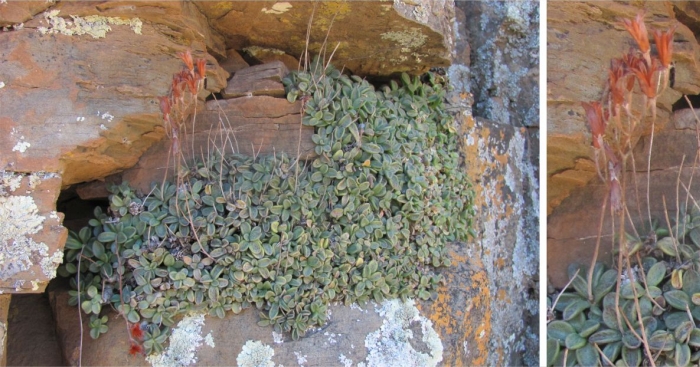
Fig. 4. A dense cluster of Adromischus humilis filling up the entire growth space allowed by the cliff, with dried ascending inflorescences.
The associated vegetation consists of a mosaic of Roggeveld Karoo (Succulent Karoo Biome) and Roggeveld Shale Renosterveld (Fynbos Biome) (Mucina & Rutherford 2006). Associated cliff-dwelling plants (cremnophytes) include: Crassula montana subsp. montana, Pelargonium articulatum, Crassula dependens, Haworthia marumiana var. archeri, Asplenium cordifolium, moss, a species of Gethyllis and various species of lichen (Parmelia sp. and others).
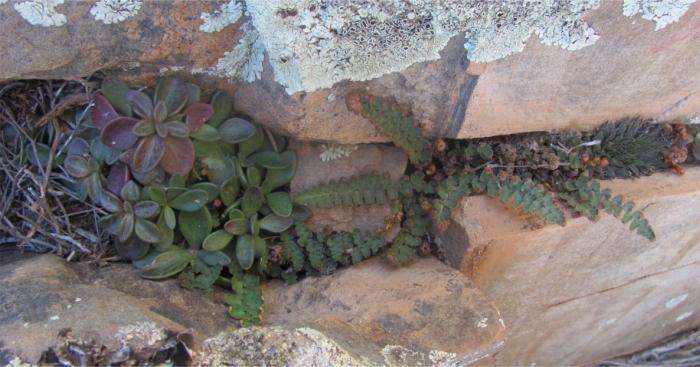
Fig. 5. Adromischus humilis sharing its habitat with the fern Asplenium cordifolium, Haworthia marumiana var. archeri and a species of lichen.
Derivation of name and historical aspects
History
The genus name Adromischus is derived from the Greek adros, meaning ‘thick’ and mischos, meaning ‘a stalk’.
The Latin species name humilis means ‘lowly, humble or low’ and pertains to its dwarf habit and humble size. Adromischus humilis was named by the German succulent student Karl von Poellnitz (1869-1945) in 1940. Karl was a keen student of succulent plants, and was interested in South African succulents. He lost his life when his castle was bombed during the second world war, in 1945. The genus Poellnitzia, in Asphodelaceae, was named in his honour.
Adromischus humilis is one of 6 species of Adromischus that belong in section Brevipedunculati. This section was established by Karl von Poellnitz in 1940 to accommodate those species characterised by funnel-shaped, glaucous-green (rarely pink) corolla tubes that are slightly grooved at their ends, and with minute club-shaped hairs on the inner surfaces of lobes and throats. The colour of the lobes varies from white to dark mauve and rarely orange (A. phillipsiae). Other members of this section include A. caryophyllaceus, A. diabolicus, A. fallax, A. phillipsiae and A. nanus. Of these A. diabolicus and A. fallax are also associated with cliffs.
Adromischus humilis comes closest to A. phillipsiae, which is the only bird pollinated Adromischus with pendent red flowers, and A. fallax. All three produce soft, succulent leaf rosettes that lack the horny leaf margin and are confined to the southern and western Escarpment Mountains from Graaff Reinet to the Richtersveld in the north. These 3 closely related species are stoloniferous, with extended, elongated branches, becoming a rosette at the tips.
The genus Adromischus was established by Lemaire in 1852 but only came into use in 1930 due to the work of Alwin Berger (Pilbeam et al. 1998). It belongs to the Crassulaceae family. With a few exceptions, all species of Adromischus are endemic to South Africa. The last revision of Adromischus was by Toelken in the Flora of southern Africa in 1985, in which 23 species were recognised. Three taxa have been added since, A. inamoenus subsp. orientalis, A. cristatus subsp. mzimvubuensis and A. schuldtianus subsp. brandbergensis (Van Jaarsveld & Van Wyk 2003, Van Jaarsveld et al. 2004). Of the 27 known species, 11 taxa are mostly associated with cliff faces. These include A. cristatus var. mzimvubuensis, A. cristatus var. schonlandii, A. cristatus var. zeyheri, A. diabolicus, A. fallax, A. humilus, A. leucophyllus, A. liebenbergi subsp. orientalis, A. schuldtianus. subsp. brandbergensis, A. subdistichus and A. umbraticola subsp. ramosus.
For those interested in Adromischus, see the book ‘Adromischus, the Cactus File Handbook’ published in 1998, by John Pilbeam, Chris Rodgerson and Derek Tribble. Derek Tribble, at the time, re-introduced two collections of Adromischus humilis plants to Europe from the Karoo Desert National Botanical Garden, the one by Bruce Bayer (Langberg) and the other of unknown origin, both are depicted in this wonderful, well-illustrated handbook.
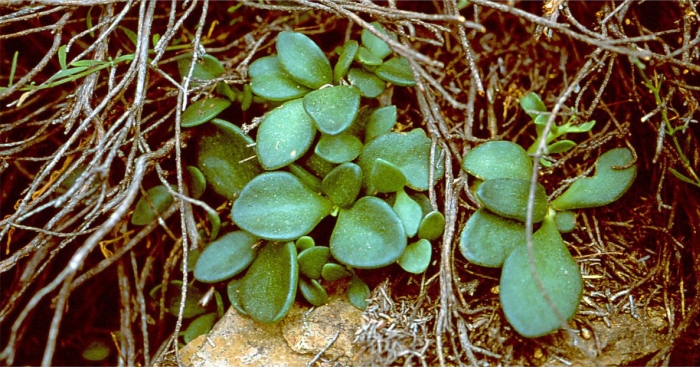
Fig. 6. A cluster Adromischus humilis growing in the shade of cliff vegetation at Rooikloof, northwest of Sutherland, Western Cape.
Ecology
Ecology
Adromischus humilis proliferates from subterranean stolons, forming dense clusters. The leaves grow ascending-spreading, in tight rosettes. This appears to be an adaptation to maximise distribution of light, the longer and short rays, within the leaf tissue on the shady cliff face. The very swollen nature of the leaves, stems and roots reflects their ability to store moisture on the extreme, well-drained cliffs.
The leaves are green to lightly greyish green, becoming purplish green when drought stressed, minimising absorption of light under dry conditions. They are loosely to tightly arranged. Plants are long-lived, with leaves withering from the base. The leaves have a soft texture, are not armed, the margin is entire and lacks the horny, stiff margins seen in most other species of Adromischus. Compared to the non-cliff dwelling relatives, there is a reduction in armament and camouflage, in response to fewer plant predators in the undisturbed cliff habitat. The stoloniferous nature enables a vegetative propagation back-up, allowing plants to colonise new crevices, maximising its long term survival on the cliff.
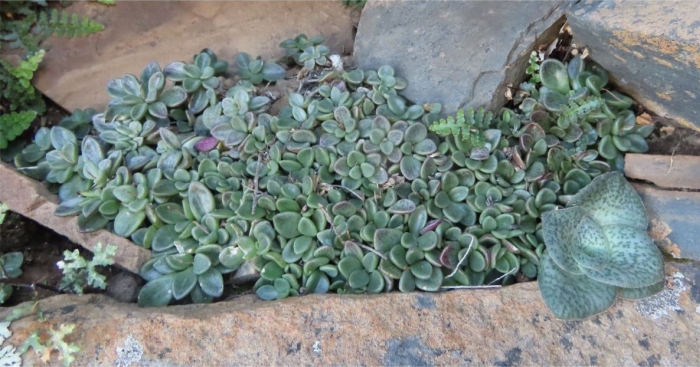
Fig. 7. Adromischus humilis growing with Crassula montana at Rooikloof between Sutherland and Fraserburg, southwestern Escarpment.
The inflorescence grows ascending to spreading, the corolla with dark, purplish reddish lobes and are probably adaptated to attract a certain flying insect that is the pollinating agent. The capsules release the seeds in autumn, coinciding with the winter rainfall. Moisture is retained longer in the substrate during this cooler time of the year, thus providing the best chance of germinating. The seeds are small, light and angular, ideal for establishment in crevices, they are shaken from the capsules and dispersed by wind.

Fig. 8. A group Adromischus humilis in flower below an overhang.
Uses
Use
No cultural or medicinal uses have been recorded.

Fig. 9. A cluster of Adromischus humilis growing in the shade of a rock overhang, the flowers exposed.
Growing Adromischus humilis
Grow
A rapidly dividing plant, forming dense clusters, it is usually easily grown and is becoming a popular pot plant in cultivation (Pilbeam et al 1998). It grows best in dappled shade, in a gravely or sandy loam to loamy soil which drains well. Plants rapidly respond to watering, becoming turgid, filling the containers but avoid over watering as plants tend to rot. Water should be provided throughout the year, but sparingly. Plants can be fed with an organic fertiliser throughout the year. Its very easy growing nature maximises its survival rate. Plants adapt well to containers. In regions outside of its habitat, ceramic containers are the solution. It also grows well with other succulents in miniature succulent gardens where conditions can be controlled.
Plants are easily propagated by division or stem cuttings during late summer. According to Pilbeam et al. (1998), unlike most other Adromischus which are easily grown from leaf cuttings, this species is difficult to root from leaves. Sow seeds in winter or spring, in a shallow tray, in a sandy mixture, and keep moist. Germination is within 3 weeks and once large enough to handle, transfer to individual containers. Place container in a shady position but with full light. The south side of a building is ideal.
Plants are relatively disease free, except for root rot caused by too much watering, but aphids, wine weevils, slugs and snails can sometimes be a problem.
References
- Jackson, W.P.U. 1990. Origins and meanings of names of South African plant genera. University of Cape Town.
- Johnson, M.R., et al. 2006. Sedimentary rocks of the Karoo Supergroup. In M.R. Johnson, C.R. Anhaeusser & R.J. Thomas (eds), The geology of South Africa: 463–501. Geological Society of South Africa, Johannesburg Council for Geoscience, Pretoria.
- Mucina, L. & Rutherford, M.C. (eds) 2006. The vegetation of South Africa, Lesotho and Swaziland. Strelitzia 19. South African National Biodiversity Institute, Pretoria.
- Pilbeam, J., Rodgerson, C. & Tribble, D. 1998. Adromischus. The Cactus File Handbook 3. Cirio Publishing Services, Southampton.
- Raimondo, D., Von Staden, L., Foden, W., Victor, J.E., Helme, N.A., Turner, R.C., Kamundi, D.A. & Manyama, P.A. (eds) 2009. Red list of South African plants. Strelitzia 25. South African National Biodiversity Institute, Pretoria.
- Toelken, H. R. 1985. Adromischus in Crassulaceae, Flora of southern Africa (ed. O.A. Leistner. Botanical Research Institute, Department of Agriculture and Water Supply.
- Toelken, H.R. 1978. New taxa and combinations in Cotyledon and allied genera. Bothalia 12(3): 377–393.
- Van Jaarsveld, E.J. 2010. Waterwise gardening in South Africa and Namibia. Struik, Cape Town.
- Van Jaarsveld, E.J., Nordenstam, B. & Van Wyk, A.E. 2004. Adromischus schuldtianus subsp. brandbergensis, a new subspecies and a checklist of the succulent flora of the Brandberg, Namibia. Bothalia 34: 35–38.
- Van Jaarsveld, E.J. & Van Wyk, A.E. 2003. New cliff-dwelling Crassulaceae from the Eastern Cape: a new Cotyledon and two new Adromischus taxa from the Mbashe and Mzimvubu Rivers, South Africa. Aloe 40(2): 36–40.
- Von Poellnitz, K. 1940. Zur Kenntnis der Gattungen Cotyledon L. und Adromischus Lem. Feddes repertorium specierum novarum regni vegetabilis, Zeitschrift für systematische Botanik 48: 80–113.
Credits
Ernst van Jaarsveld
Kirstenbosch National Botanical Garden (Retired 2015)
Babylonstoren Farm
Extraordinary senior lecturer and researcher,
Department of Biodiversity and Conservation, University of the Western Cape
May 2022
Acknowledgements: the author thanks Stewie Theron and Abel Kersop for assistance in the field.
Plant Attributes:
Plant Type: Succulent
SA Distribution: Northern Cape, Western Cape
Soil type: Sandy, Loam
Flowering season: Late Summer
PH: Acid, Neutral
Flower colour: Green, Purple, Pink
Aspect: Shade, Morning Sun (Semi Shade), Afternoon Sun (Semi Shade)
Gardening skill: Easy
Special Features:
Horticultural zones







Rate this article
Article well written and informative
Rate this plant
Is this an interesting plant?
Login to add your Comment
Back to topNot registered yet? Click here to register.